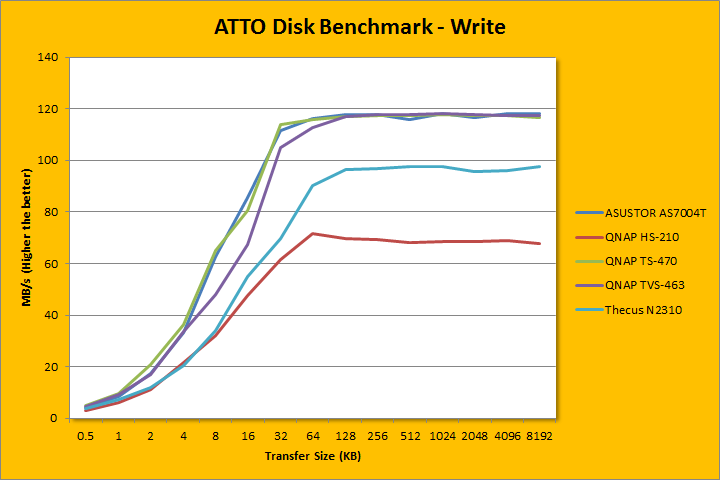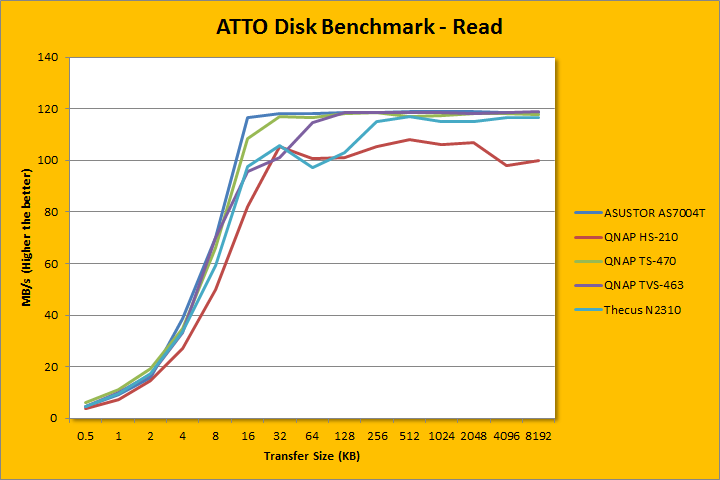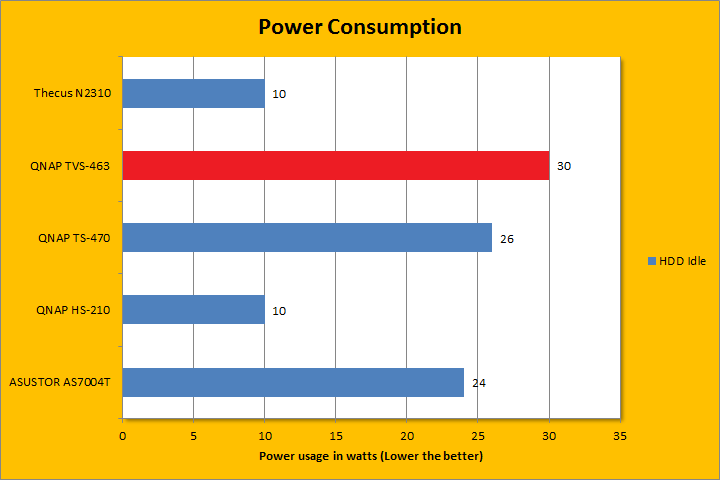Page 7 - Performance and Power Consumption
For our tests, the QNAP TVS-463 was connected to our central home network with CAT5e wiring. Our test station was located two stories away from the NAS to simulate real world performance in a centralized networking environment. One Seagate NAS HDD ST4000VN000 4TB was installed in the TVS-463 for the purpose of benchmarking. The client computer was configured with the following specifications:
CPU: Intel Core i7-4790K @ 4.60GHz
CPU Cooling: Noctua NH-D15 (Single fan)
Motherboard: Gigabyte GA-Z97X-UD3H-BK
RAM: Patriot Viper 3 Low Profile PC3-17000 4x8GB
Graphics: Gigabyte G1 Gaming GeForce GTX 970 4GB
Chassis: Fractal Design Define R5
Storage: OCZ RevoDrive 350 480GB; SanDisk Extreme PRO 480GB; OCZ Vector 150 240GB
Power: Seasonic Platinum 1000W
Sound: Auzentech X-Fi HomeTheater HD
Operating System: Microsoft Windows 8.1 Professional x64
Compared Hardware:
- QNAP TVS-463
- ASUSTOR AS7004T
- QNAP TS-470
- QNAP HS-210
- Thecus N2310


Equipped with the Seagate NAS HDD ST4000VN000 4TB, our QNAP TVS-463 was ready to roll. From our experience in benchmarking, Intel Gigabit LAN adapters -- at least on the client side -- perform much better than their Realtek and Marvell counterparts. Therefore, to prevent any bottlenecks on the client side, our Gigabyte GA-Z97X-UD3H-BK motherboard was connected to the network via its integrated Intel Gigabit LAN adapter. We also conducted the above test on our OCZ Vector 150 240GB solid state drive on the client side to ensure there was nothing limiting the performance of our QNAP TVS-463 than the NAS itself. In turn, the results were quite impressive. As you can see in our graphs above, the QNAP TVS-463 was capable of doing approximately 102.24MB/s for write and 109.32MB/s for read using the Seagate NAS HDD. In fact, it was even faster than the renowned QNAP TS-470, which is regarded as one of the best performing network attached storage systems here at APH Networks. In fact, it got close to the ASUSTOR AS7004T, the fastest NAS in this test. At this point, the bandwidth of Gigabit LAN is more or less the limitation.


ATTO disk benchmark provides valuable insight into evaluating disk performance; it is especially valuable since it is not local disk limited like Windows file copy -- but rather the network adapter itself. After first using it in our QNAP TS-559 Pro+ review nearly five years ago, ATTO has been an integral part of our storage benchmarks; used in everything ranging from USB flash drives to solid state disks. Venturing in the area of 118.776MB/s in read and 117.993MB/s write for pretty much everything 64K and up, remember that the theoretical maximum of Gigabit Ethernet is 'only' 125MB/s (1000Mbps / 8) with overhead -- this is about as fast as it gets. Under the curve, it is a little slower than the ASUSTOR AS7004T and QNAP TS-470. At peak, the QNAP TVS-463 is limited only by the network interface, and not the performance of the NAS itself. At the end of the day, this is still a seriously fast system.


With one Seagate NAS hard drive installed, power consumption for our specific configuration is only 35W under load, which is slightly better than the ASUSTOR AS7004T and QNAP TS-470. However, its idle power is considerably higher than its Intel based counterparts; the AS7004T with a Core i3-4330 and TS-470 with an Intel Celeron G550 both consumed considerably less wattage in the same conditions. Power consumption will drop if the hard drives are configured to turn off if they are not used, or when the QNAP TVS-463 is sent into standby mode, but 30W of idle power leaves a bit to be desired. Considering it is going to be running 24/7, every watt will definitely add up.
Page Index
1. Introduction, Packaging, Specifications
2. A Closer Look - Hardware (External)
3. A Closer Look - Hardware (Internal)
4. Configuration and User Interface, Part I
5. Configuration and User Interface, Part II
6. Configuration and User Interface, Part III
7. Performance and Power Consumption
8. Conclusion





